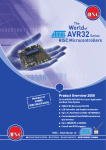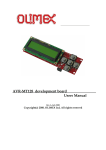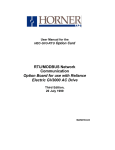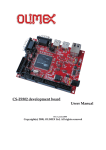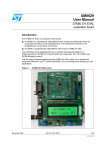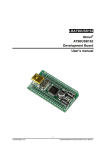Download AVR-USB-STK User Manual
Transcript
AVR-USB-STK development board Users Manual All boards produced by Olimex are ROHS compliant Rev.A, July 2008 Copyright(c) 2008, OLIMEX Ltd, All rights reserved INTRODUCTION: AVR-USB-STK is easy to use development board for the new AT90USB162 microcontroller. With AT90USB162 is very easy to develop USB functionality to your next device, as Atmel provide free open source HID (mouse, keyboard) and CDC (USB-to-RS232) code and on top of this AT90USB162 cost is same as ATMega16, so what you are waiting for? AVR-USB-STK board allow all USB features of AT90USB162 to be explored. The board have USB connector, Joystick, RS232, SD-MMC card, Audio output, ICSP connector and extension connector. All AT90USB162 come from Atmel pre-programmed with bootloader which allow code to be programmed inside the chip without any external programmer, just download the FLIP software from Atmel web site and load your HEX code inside AT90USB162. To enter the bootloader mode you should press and hold HWB button, then press and release RST button. If you prefer to use ICSP programmer note that only AVR-DRAGON and AVR-ISP-MK2 is supporting AT90USB162 as these are pretty new devices, probably AVR Dude will add support later, but for the moment you can't use AVR-PG1 or AVR-PG2 for ICSP programming, another bad news is that AT90USB162 supports only debug Wire not JTAG so to debug it you should have the expensive AT-JTAGICE-MK2 or AVR-DRAGON. BOARD FEATURES: - AT90USB162 microcontroller with 16KB Flash, 512B RAM, 512B EEPROM ICSP 5x2 pin connector for in-circuit programming with AVR-ISP-MK2 (you generally don't need to use ICSP as you can program via USB) Debug Wire could be performed by 3 wires connected to ICSP (ATJTAGICE-MK2 have such lose wire connector which to be used, you need VCC, GND, RST signals only) USB 2.0 Full speed connector RS232 driver and connector SD-MMC card connector Audio out 3.5 mm jack connector Extension connector with AVR port signals Status LED Joystick User button HWB (can be used to enter bootloader mode after reset) Reset button RST Takes power from USB no need for external adapter External power supply and voltage regulator if USB can't provide enough power Quartz crystal oscillator circuit 8Mhz Extension pin headers for each uC pin Four mounting holes 3.3 mm (0.13") Grid 100 mils GND bus Vcc bus FR-4, 1.5 mm (0,062"), green soldermask, white silkscreen component print Dimensions 77x72 mm (3x2.8") ELECTROSTATIC WARNING: The AVR-USB-STK board is shipped in protective anti-static packaging. The board must not be subject to high electrostatic potentials. General practice for working with static sensitive devices should be applied when working with this board. BOARD USE REQUIREMENTS: Cables: 1.8 meter USB A-B cable. RS232 female/male DB9 cable for connecting to PC RS232 port Hardware: AVR-DRAGON, AVR-JTAGICEMK2 or compatible tools Software: AVR Studio + WinAVR free development IDE and C compiler PROCESSOR FEATURES: AVR-USB-STK uses Atmel 8-bit AVR CPU AT90USB162 with these features: - High Performance, Low Power AVR® 8-Bit Microcontroller - Advanced RISC Architecture - 125 Powerful Instructions – Most Single Clock Cycle Execution - 32 x 8 General Purpose Working Registers - Fully Static Operation - Up to 16 MIPS Throughput at 16 MHz - Non-volatile Program and Data Memories - 8K / 16K Bytes of In-System Self-Programmable Flash - Endurance: 10,000 Write/Erase Cycles - Optional Boot Code Section with Independent Lock Bits - USB boot-loader programmed by default in the factory - In-System Programming by on-chip Boot Program hardware-activated after reset - True Read-While-Write Operation - 512 Bytes EEPROM - Endurance: 100,000 Write/Erase Cycles - 512 Bytes Internal SRAM - Programming Lock for Software Security - USB 2.0 Full-speed Device Module with Interrupt on Transfer Completion - Complies fully with Universal Serial Bus Specification REV 2.0 - 48 MHz PLL for Full-speed Bus Operation : data transfer rates at 12 Mbit/s - Fully independant 176 bytes USB DPRAM for endpoint memory allocation - Endpoint 0 for Control Transfers: from 8 up to 64-bytes - 4 Programmable Endpoints: - IN or Out Directions - Bulk, Interrupt and IsochronousTransfers - Programmable maximum packet size from 8 to 64 bytes - Programmable single or double buffer - Suspend/Resume Interrupts - Microcontroller reset on USB Bus Reset without detach - USB Bus Disconnection on Microcontroller Request - USB pad multiplexed with PS/2 peripheral for single cable capability - PS/2 compliant pad - One 8-bit Timer/Counters with Separate Prescaler and Compare Mode (two 8-bit PWM channels) - One 16-bit Timer/Counter with Separate Prescaler, Compare and Capture Mode (three 8-bit PWM channels) USART with SPI master only mode and hardware flow control (RTS/CTS) Master/Slave SPI Serial Interface Programmable Watchdog Timer with Separate On-chip Oscillator On-chip Analog Comparator Interrupt and Wake-up on Pin Change On Chip Debug Interface (debugWIRE) Power-On Reset and Programmable Brown-out Detection Internal Calibrated Oscillator External and Internal Interrupt Sources Five Sleep Modes: Idle, Power-save, Power-down, Standby, and Extended Standby Operating Voltages – 2.7V – 5.5V Operating temperature - Industrial (-40°C to +85°C) BLOCK DIAGRAM: MEMORY MAP: SCHEMATIC: BOARD LAYOUT: POWER SUPPLY CIRCUIT: AVR-USB-STK can be powered from the USB port or from external power supply. The polarity of the external power supply doesn't matter as there is diode bridge at the front stage, this making possible AVR-USB-STK to be powered with AC or DC power adapters. The input voltage should be in the range of 7-12VDC or 6-9VAC. The board power consumption is about 15 mA. RESET CIRCUIT: AVR-USB-STK reset circuit consist of R4 pullup, RST button and R9 current limiting resistor. When RST button is pressed logical 0 is fed to the AT90USB162 reset input. As the reset port may be configured by the software as GPIO and output the current limiting resistor R9 is connected between the RST button and the microcontroller. CLOCK CIRCUIT: 8MHz quartz crystal is connected to AT90USB162 pin 1 (XTAL1) and pin 2 ((PC0)/XTAL2). Internal PLL generates the 48Mhz necessary for the USB. INPUT/OUTPUT: Reset button with name RST. Button with name HWB, connected to AT90USB162 pin 13 ((#CTS/#HWB/ TD/INT7)/PD7) which, if pressed, could activate the USB Bootloader after reset or could be used as user button. Joystick with name JOYSTICK_MT5_F with four used positions (up, down, right, left). Power LED (red) with name PWR. User status LED (red) with name STAT. JUMPER DESCRIPTION: HP_SB_E When the jumper is closed, it enables AT90USB162 to control standby function of the audio amplifier U3 (TS4871). When the jumper is open, U3 enter standby mode. Default state is closed. the CONNECTOR DESCRIPTIONS: ICSP: Pin # Signal Name Pin # Signal Name 1 MOSI 2 VCC (+3.3V) 3 NC 4 GND 5 RST 6 GND 7 SCLK 8 GND 9 MISO 10 GND MOSI I/O Master Out Slave In. SPI data transfer signal. It is either input or output depending on whether the MCU is master or slave. SCLK I/O Serial (Synchronization) Clock. This is the synchronization signal. It could be either input (MCU – slave) or output (MCU – master). MISO I/O Master In Slave Out. SPI data transfer signal. It is either input or output depending on whether the MCU is master or slave. EXT: Pin # Signal Name Pin # 3.3V Signal Name GND VIN EXT_PWR PB0 B5(SELECT) PB1 SCLK PB2 MOSI PB3 MISO PB4 B1(LEFT) PB5 B2(UP) PB6 B3(RIGHT) PB7 B4(DOWN) PC1 RST PC2 CS_SD/MMC PC4 USB_P PC5 PWM_OUT PC6 STNBY PC7 INT4/ICP1 PD1 CP PD0 +5V_USB +5V (OC.OB/INT0) PD2 RXD1 PD3 TXD1 PD4 (INT5) PD5 WP PD6 #RTS PD7 #CTS/PD7 VIN Input Voltage In. You could apply external voltage at this pin. MOSI I/O Master Out Slave In. SPI data transfer signal. It is either input or output depending on whether the MCU is master or slave. MISO I/O Master In Slave Out. SPI data transfer signal. It is either input or output depending on whether the MCU is master or slave. SCLK I/O Serial (Synchronization) Clock. This is the synchronization signal. It could be either input (MCU – slave) or output (MCU – master). USB_P Input USB Power. The board could take power supply over the USB. PWM_OUT Output PWM Output. This signal is passed to the headphones amplifier. STNBYOutputStand-by. This signal controls the standby mode of the audio amplifier. CP Input Card Present. This signal is part of the SD/MMC interface. RXD1 Input Receive Data. This is the asynchronous data input for the RS232 interface. TXD1 OutputTransmit Data. This is the asynchronous data output for the RS232 interface. WP Input Write Protection. This signal is part of the SD/MMC interface. #RTS OutputRequest To Send. This signal is part of the RS232 interface. #CTS Input Clear To Send. This signal is part of the RS232 interface. RS232 Pin # Signal Name Pin # Signal Name 1 NC 6 to pin 4 2 TXDOUT 7 RS-CTS 3 RXDIN 8 RS-RTS 4 to pin 6 9 GND 5 GND TXDOUT Output Transmit Data. This is the asynchronous data output for the RS232 interface. RXDOUT InputReceive Data. This is the asynchronous data input for the RS232 interface. #RTS OutputRequest To Send. This signal is part of the RS232 interface. #CTS Input Clear To Send. This signal is part of the RS232 interface. SD-MMC Pin # Signal Name Pin # Signal Name 1 CS_SD/MMC 9 Pull-up to 3.3V 2 MOSI 10 WP 3 GND 11 Not Connected 4 VDD 12 Not Connected 5 SCLK 13 CP 6 GND 14 Pull-down 7 MISO 15 Pull-down 8 Pull-up to 3.3V CS_SD/MMC Output Chip Select SD/MMC. This signal enables and disables the SD/MMC connector. MOSI Output Master Out Slave In. As the access to the memory is via SPI interface, this is data output from the MCU (which is master) and input for the memory card (which is slave). WP Input Write Protection. This signal is part of the SD/MMC interface. SCLK Output Serial (Synchronization) Clock. This is the synchronization clock for the data transfer. CP Input Card Present. This signal is part of the SD/MMC interface. MISO Input Master In Slave Out. As the access to the memory card is via SPI interface, this is data input for the MCU(which is master) and data output from the memory card (which is slave). USB Pin # Signal Name 1 +5V 2 D– 3 D+ 4 GND D- and D+ both form differential input or output depending on the direction of the data flow. PWR_JACK Pin # Signal Name 1 9VDC/6VAC 2 GND Audio Out: MECHANICAL DIMENSIONS: All measurements are in inches. ORDER CODE: AVR-USB-STK – assembled and tested (no kit, no soldering required) How to order? You can order to us directly or by any of our distributors. Check our web www.olimex.com/dev for more info. Revision history: REV.A - created July 2008 Disclaimer: © 2008 Olimex Ltd. All rights reserved. Olimex®, logo and combinations thereof, are registered trademarks of Olimex Ltd. Other terms and product names may be trademarks of others. The information in this document is provided in connection with Olimex products. No license, express or implied or otherwise, to any intellectual property right is granted by this document or in connection with the sale of Olimex products. Neither the whole nor any part of the information contained in or the product described in this document may be adapted or reproduced in any material from except with the prior written permission of the copyright holder. The product described in this document is subject to continuous development and improvements. All particulars of the product and its use contained in this document are given by OLIMEX in good faith. However all warranties implied or expressed including but not limited to implied warranties of merchantability or fitness for purpose are excluded. This document is intended only to assist the reader in the use of the product. OLIMEX Ltd. shall not be liable for any loss or damage arising from the use of any information in this document or any error or omission in such information or any incorrect use of the product.

















